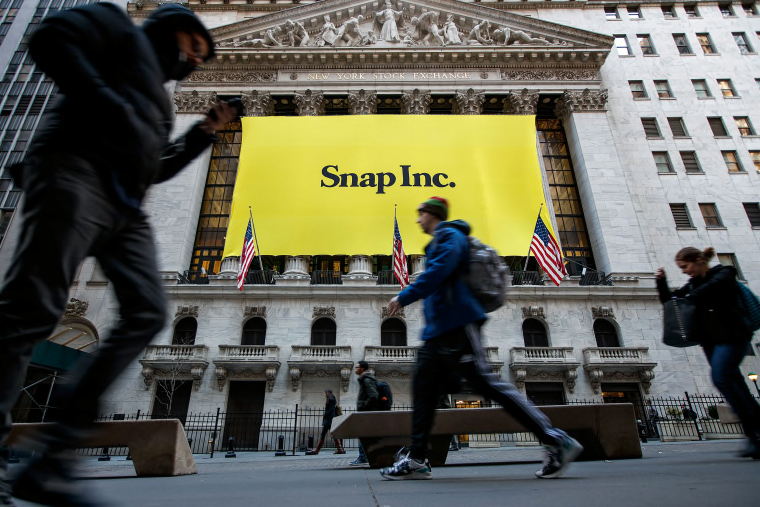The Finance Ghost
- 4 min read
Apple snaps Snap’s ad revenue

A lot of tech investors are starting to understand the risks of a frothy market. When companies are trading at eye-watering revenue multiples, any disappointment is punished severely by the market.
Snap Inc. (owner of Snapchat) now has a market cap of around $84.5 billion and quarterly revenue of over $1 billion, a milestone reached for the first time in Q3’21. If we work on an annualised multiple (simply taking the current quarterly revenue and multiplying it by four), then the company is trading on an annualised revenue multiple of over 21x.
Here’s the real kicker though: the share price is down 30% in the past week. Heading into the latest quarter, the annualised revenue multiple was over 30x. At those levels, there was absolutely no margin for error.
Earlier this year, Snap told the market that it would be able to grow at a 50% multi-year revenue rate. This means that revenue should double roughly every 20 months, a rather brave prediction to put out there. Although revenue grew 57% in Q3’21, the company has guided revenue growth of “only” 28% to 32% in Q4’21.

That was enough to drive a 30% nosedive in the share price. Year-to-date, Snap Inc is now only up around 5.5%. Technically, you would’ve been better off paying down your bond on 1 January than putting money in Snap.
For such a sharp drop in the share price, surely something has gone terribly wrong with the app?
Well, not quite. Snapchat reaches more than 500 million people, including more than 75% of 13- to 34-year-olds in the US, Canada, France, the UK, Australia and the Netherlands. There are 306 million daily active users, and the company is growing users more than 20% year-on-year.
The problem clearly isn’t with the app. Are user growth prospects perhaps the issue?
Snap only has a 5% penetration rate in the smartphone population outside of the US and Europe. By investing in regional content and creator communities, the business is not as US-heavy as one might expect. Daily active users are 96 million in North America, 80 million in Europe and 130 million in Rest of World.
There’s a significant growth trajectory ahead and the app is highly popular with a younger audience, which advertisers love. None of this suggests that the company should’ve dropped 30%, so what caused the problem?
There are two major issues for Snap heading into Q4’21.
The first relates to supply chain problems across the globe. Simply put, when companies have empty stockrooms, they aren’t keen to spend a fortune on advertising to build demand that they cannot meet. The issues for most companies heading into the festive season are supply-related rather than demand-related.
This is a short-term problem. It doesn’t help Snap’s cause but also shouldn’t drive a 30% drop in isolation.

The much bigger issue is that Apple has caused havoc for social media platforms. Changes to iOS were rolled out by Apple in June and July, delivering enhanced privacy for Apple users and having an impact on everything from mailer open rates through to how advertisers on social media platforms measure their Return on Investment (ROI).
In the tech food chain, Apple sits right at the top. The company is effectively the gatekeeper of access to the highest income users on average, which means that any changes to iOS are huge in the world of digital advertising.
"Tim Cook has doubled down on privacy as his cause to rally the troops around. Whether those troops are the 1B+ users of Apple products or the employees looking for purpose in their day to day activities" - Jonathan Kropf, Velocity Group CEO
Snap is working on ways to deal with this. The company needs to help advertising partners navigate this world, offering fascinating technology like “sponsored augmented reality” – the ability to send teens and young adults on an adventure that looks like the real world but comes with clever (and paid-for) brand placements.
It’s not just Snap, of course. Facebook also took a knock from Apple’s privacy changes, not least of all because Facebook knows everything about you and the business depends on that fact. Still, earnings growth at both social media businesses was through the roof, so neither of these companies are about to shut their doors because of Apple.
The debate here is whether earnings growth will be high or ridiculously high. This is where the art of valuation becomes so important in investing; it’s not just about the underlying story, but also what you pay for access to it as an investor.
This situation is a reminder of two important things in the world of tech investing: (1) big multiples can lead to bigger disappointments, and (2) the operating system or platform still holds the keys to the kingdom.
For more cool and simple to understand financial insights, be sure to visit:
Share Link




